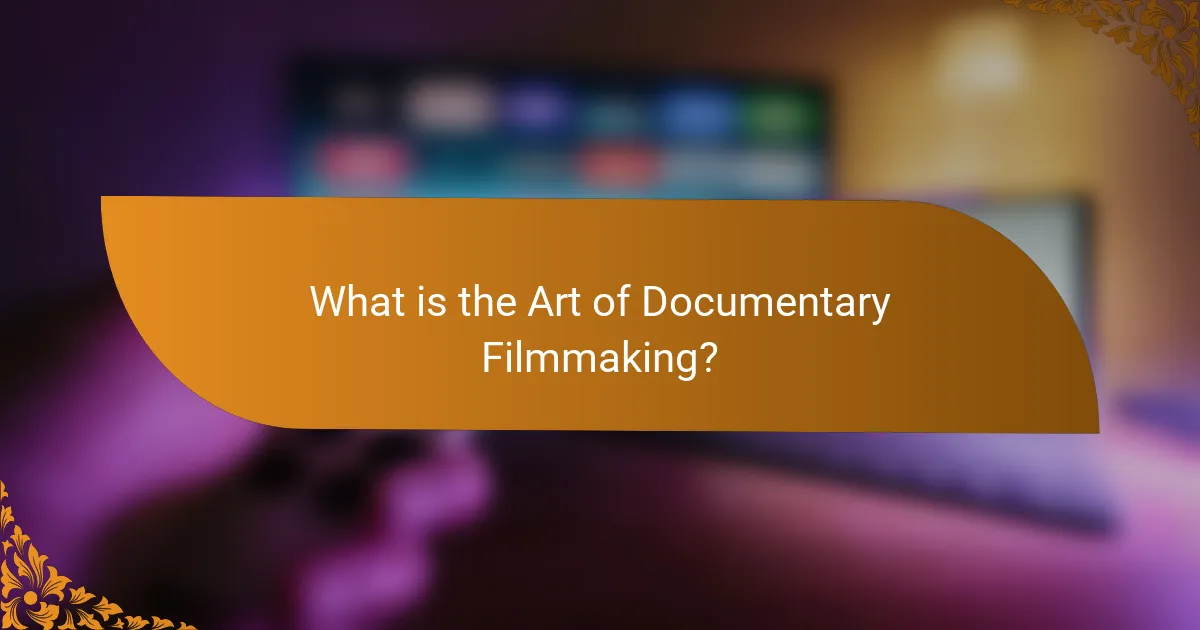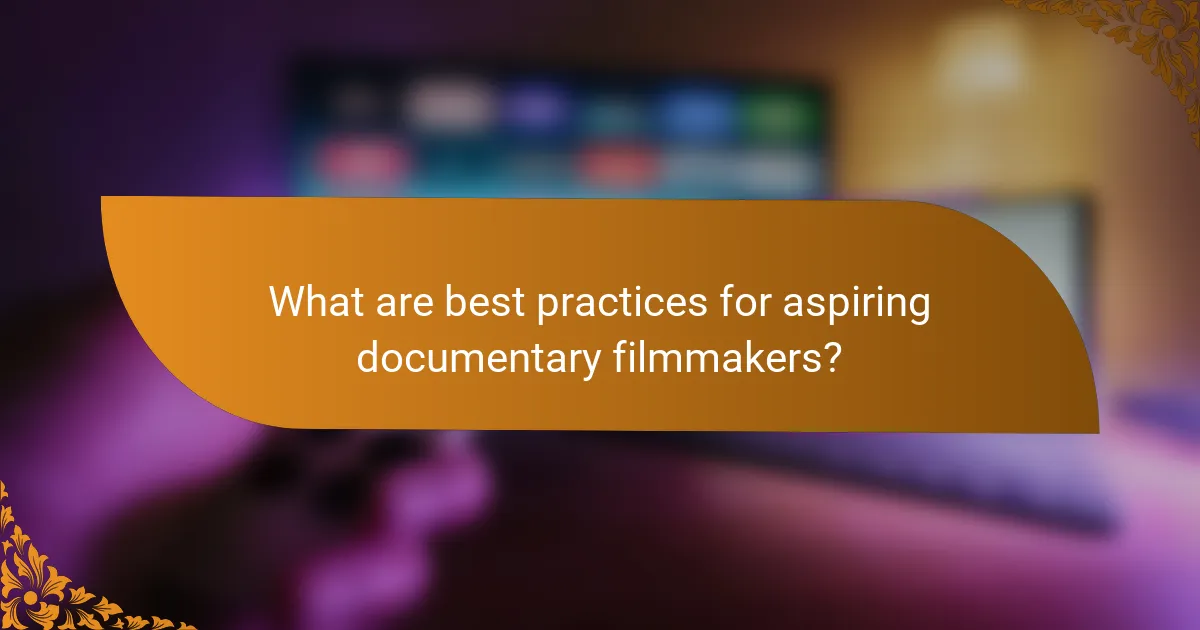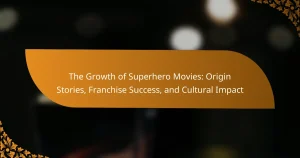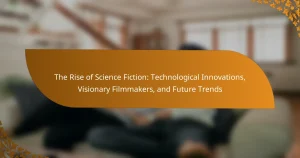
What is the Art of Documentary Filmmaking?
The art of documentary filmmaking is the practice of creating non-fiction films that document reality. It involves storytelling techniques that capture real-life events, people, and cultures. Filmmakers use various methods to engage audiences and convey messages. These methods include interviews, observational footage, and archival materials. Ethical considerations play a crucial role in this art form. Filmmakers must navigate issues of representation, consent, and truthfulness. The impact of documentary films can be significant, influencing public opinion and raising awareness on social issues. Historical examples, such as “March of the Penguins,” demonstrate the art’s power to educate and inspire.
How does documentary filmmaking differ from other film genres?
Documentary filmmaking differs from other film genres by focusing on real-life subjects and events. It aims to inform, educate, or provoke thought rather than entertain. Documentaries often utilize interviews, archival footage, and observational techniques to present factual content. Unlike fictional films, documentaries prioritize authenticity and truthfulness. They often explore social, political, or cultural issues, providing insight into real-world topics. This genre can influence public opinion and raise awareness about important issues. For instance, “An Inconvenient Truth” raised awareness about climate change through factual evidence and personal narrative. Thus, documentary filmmaking serves a unique purpose in storytelling by emphasizing factual representation over fictional narratives.
What are the key characteristics of documentary films?
Documentary films are characterized by their focus on real-life subjects and events. They aim to inform, educate, and sometimes persuade audiences. Documentary films often use interviews, archival footage, and observational techniques. They strive for authenticity and truthfulness in their portrayal of subjects. Many documentaries include a narrative structure to guide viewers through the content. They may also explore social, political, or cultural issues. The use of voiceover narration is common to provide context. Documentaries often feature a variety of styles, such as expository, participatory, or reflexive.
Why is authenticity important in documentary filmmaking?
Authenticity is crucial in documentary filmmaking because it establishes trust with the audience. Trust enhances viewer engagement and emotional connection. Documentaries aim to present real stories and facts. Authenticity ensures that the representation of subjects is accurate and respectful. When filmmakers present genuine narratives, they honor the experiences of the individuals involved. This adherence to truth fosters credibility for the documentary. According to a study by the University of Southern California, audiences are more likely to resonate with documentaries perceived as authentic. Authenticity also differentiates documentaries from fictional narratives, reinforcing their educational and informative purpose.
What are the fundamental storytelling techniques in documentary filmmaking?
The fundamental storytelling techniques in documentary filmmaking include interviews, observational footage, and archival materials. Interviews provide personal insights and perspectives from subjects. Observational footage captures real-life events as they unfold, offering authenticity. Archival materials, such as photographs or historical videos, add context and depth to the narrative. These techniques work together to create a compelling and informative story. According to the International Documentary Association, effective use of these techniques enhances viewer engagement and understanding.
How do filmmakers create compelling narratives in documentaries?
Filmmakers create compelling narratives in documentaries by employing storytelling techniques that engage audiences. They start with strong, relatable characters to draw viewers in. Filmmakers often use a clear structure to guide the narrative flow. This structure typically includes a beginning that introduces the subject, a middle that develops the conflict, and an end that provides resolution.
They incorporate visual storytelling elements to enhance emotional impact. Cinematic techniques like close-ups, framing, and sound design contribute to the narrative. Filmmakers also utilize interviews and personal stories to provide authenticity. This approach allows for a deeper connection between the audience and the subject matter.
Moreover, filmmakers often highlight universal themes that resonate with viewers. Themes such as resilience, hope, and social justice create a lasting impression. By combining these elements, filmmakers craft narratives that are not only informative but also emotionally compelling.
What role does character development play in documentary storytelling?
Character development is crucial in documentary storytelling. It creates emotional connections between the audience and the subjects. Well-developed characters allow viewers to engage with the narrative on a personal level. This engagement fosters empathy and understanding of the subjects’ experiences. Documentaries often present real-life struggles, making character depth essential for authenticity. For example, films like “Won’t You Be My Neighbor?” illustrate the impact of character development through the life of Fred Rogers. Such documentaries highlight how personal stories resonate with audiences, enhancing the overall storytelling experience.
How can visual elements enhance the storytelling in documentaries?
Visual elements enhance storytelling in documentaries by providing visual context and emotional engagement. They help convey complex information quickly and effectively. For instance, imagery can illustrate themes and ideas that may be difficult to articulate through words alone. Visuals can evoke emotions, drawing the audience into the narrative. Research shows that viewers retain information better when it is presented visually. Studies indicate that approximately 65% of people are visual learners. This means that integrating visuals can significantly impact audience understanding and retention of the documentary’s message.
What ethical considerations must filmmakers keep in mind?
Filmmakers must prioritize respect for subjects’ rights and dignity. This includes obtaining informed consent from participants. Filmmakers should also consider the potential impact of their work on individuals and communities. Ethical storytelling requires accuracy and honesty in representation. Filmmakers should avoid exploitation or manipulation of vulnerable subjects. They must be mindful of cultural sensitivities and avoid perpetuating stereotypes. Transparency about funding and affiliations is crucial to maintain credibility. Adhering to these ethical considerations fosters trust and integrity in documentary filmmaking.
How do filmmakers balance truth and storytelling?
Filmmakers balance truth and storytelling by integrating factual elements with narrative techniques. They often use real events and interviews to provide authenticity. At the same time, they structure these elements into a compelling narrative arc. This approach engages viewers emotionally while conveying factual information. For instance, in documentaries like “The Act of Killing,” filmmakers blend reenactments with interviews to highlight the complexities of truth. This method allows for a deeper exploration of subjects while maintaining a connection to reality. Balancing these aspects requires careful consideration of ethical implications and audience impact.
What are the implications of consent and representation in documentaries?
Consent and representation in documentaries significantly impact ethical storytelling. Consent ensures that subjects agree to be portrayed, which respects their autonomy. Without proper consent, filmmakers risk exploitation and misrepresentation. Representation affects how stories are perceived by audiences. Diverse and accurate representation fosters empathy and understanding. Conversely, biased or stereotypical portrayals can perpetuate harmful narratives. Ethical guidelines, such as those from the International Documentary Association, emphasize the importance of informed consent and fair representation. These guidelines help maintain integrity in documentary filmmaking. Overall, consent and representation are crucial for ethical storytelling and audience engagement.
Why is it important to avoid exploitation in documentary filmmaking?
Avoiding exploitation in documentary filmmaking is crucial for ethical storytelling. Exploitation can harm subjects and misrepresent their experiences. Documentaries should prioritize the dignity and consent of individuals featured. This approach builds trust with audiences and subjects alike. Moreover, ethical practices enhance the credibility of the documentary. Studies show that documentaries perceived as exploitative can lead to public backlash. Therefore, filmmakers must adhere to ethical standards to foster respect and authenticity in their work.

How do impactful subjects shape documentary filmmaking?
Impactful subjects significantly shape documentary filmmaking by influencing narrative direction and audience engagement. They provide compelling stories that resonate with viewers. For instance, topics like climate change or social justice evoke strong emotional responses. Documentaries that focus on impactful subjects often aim to raise awareness or provoke action. The success of films like “13th” and “My Octopus Teacher” illustrates this phenomenon. These films not only inform but also inspire dialogue and change. Research shows that documentaries addressing impactful subjects can increase public understanding and empathy. Thus, the choice of subject is crucial in defining the film’s purpose and effectiveness.
What types of subjects are commonly explored in documentaries?
Documentaries commonly explore a variety of subjects. These subjects include social issues, historical events, nature, and culture. Social issues often focus on topics like poverty, inequality, and human rights. Historical events can cover significant moments in history, such as wars or revolutions. Nature documentaries showcase wildlife, ecosystems, and environmental concerns. Cultural documentaries highlight traditions, arts, and practices of different communities. Additionally, personal stories and biographies of influential figures are frequently depicted. These subjects provide audiences with insights and provoke thought on various aspects of life and society.
How do social issues influence documentary topics?
Social issues significantly influence documentary topics by shaping the narratives filmmakers choose to explore. Documentaries often aim to raise awareness about pressing societal concerns. Issues like poverty, inequality, and climate change frequently serve as focal points. Filmmakers select these topics to engage audiences and provoke thought. The impact of social movements also plays a crucial role in topic selection. For instance, the Black Lives Matter movement has inspired numerous documentaries highlighting racial injustice. Statistics show that documentaries addressing social issues can lead to increased public discourse. According to a study by the University of Southern California, socially relevant documentaries often result in measurable changes in audience attitudes. Thus, social issues are central to the thematic development of many documentaries.
What role does personal experience play in selecting documentary subjects?
Personal experience significantly influences the selection of documentary subjects. Filmmakers often draw from their own backgrounds and emotions. This connection can enhance storytelling and authenticity. Personal experiences allow filmmakers to approach subjects with empathy. They can provide unique insights that resonate with audiences. For instance, a filmmaker who experienced homelessness may create a more compelling narrative on that topic. This authenticity can lead to deeper engagement from viewers. Research shows that personal connection often results in more impactful documentaries.
Why is audience engagement crucial in documentary filmmaking?
Audience engagement is crucial in documentary filmmaking because it enhances viewer connection and retention. Engaged audiences are more likely to absorb the content and reflect on its themes. Research indicates that documentaries with high engagement levels can lead to increased awareness and action on social issues. For instance, a study by the University of Southern California found that emotionally engaging documentaries significantly impact viewers’ attitudes and behaviors. This connection fosters a deeper understanding of the subject matter, making the documentary more impactful. Ultimately, effective audience engagement transforms passive viewers into active participants in the narrative.
How can filmmakers connect emotionally with their audience?
Filmmakers can connect emotionally with their audience by crafting relatable characters and compelling narratives. By developing characters that reflect real human experiences, filmmakers foster empathy. Emotional storytelling techniques, such as using music and visual imagery, enhance the viewer’s connection. For example, studies show that music can evoke specific emotions, influencing audience reactions. Additionally, authentic dialogue and genuine performances contribute to emotional resonance. Filmmakers also utilize pacing and editing to build tension and release, guiding audience emotions throughout the film. By addressing universal themes, such as love, loss, and hope, filmmakers create a shared emotional experience. Overall, these methods effectively engage viewers on a deeper level.
What techniques can be used to spark discussions around documentary subjects?
Techniques to spark discussions around documentary subjects include engaging storytelling, interactive screenings, and audience participation. Engaging storytelling captivates viewers and encourages them to share their thoughts. Interactive screenings allow audiences to ask questions and express opinions in real-time. Audience participation can be facilitated through Q&A sessions or discussion panels after screenings. Additionally, using social media platforms to share clips or quotes from the documentary can stimulate online discussions. Creating discussion guides with thought-provoking questions can also encourage deeper conversations. These methods are effective in fostering dialogue and enhancing viewer engagement with documentary subjects.

What are best practices for aspiring documentary filmmakers?
Aspiring documentary filmmakers should research their subject thoroughly. Understanding the context and background is crucial for authenticity. They must develop a compelling narrative that engages the audience. A well-structured story enhances viewer interest and retention. Building strong relationships with subjects fosters trust and openness. This leads to more genuine and impactful storytelling. Filmmakers should also focus on ethical considerations. Respecting the privacy and dignity of subjects is paramount. Properly crediting sources and contributors maintains integrity. Finally, continuous learning and feedback are essential for growth. Engaging with the filmmaking community can provide valuable insights and opportunities.
How can filmmakers effectively plan their documentary projects?
Filmmakers can effectively plan their documentary projects by establishing a clear vision and outline. This involves defining the documentary’s purpose and target audience. Conducting thorough research on the subject matter is essential. Filmmakers should identify key themes and messages to convey. Creating a detailed production schedule helps manage timelines and resources. Budgeting accurately ensures financial feasibility throughout the project. Additionally, assembling a skilled team is crucial for execution. Filmmakers should also secure necessary permissions and legal clearances in advance. These steps collectively enhance the documentary’s quality and impact.
What steps should be taken during the pre-production phase?
The pre-production phase involves several essential steps. First, define the documentary’s concept and objectives. This sets the foundation for the project. Next, conduct thorough research on the subject matter. Research provides factual context and informs the narrative. Following this, create a detailed script or outline. This serves as a roadmap for filming. Assemble a production team, including a director, camera operators, and sound technicians. A skilled team enhances the documentary’s quality. Additionally, scout and secure filming locations. This ensures accessibility and suitability for the story. Finally, develop a budget and schedule. This helps manage resources and timelines effectively. Each of these steps is crucial for a successful documentary project.
How can filmmakers ensure a smooth production process?
Filmmakers can ensure a smooth production process by thorough planning and organization. Developing a detailed production schedule helps allocate time effectively. Budgeting accurately prevents financial issues during filming. Assembling a skilled crew enhances efficiency and collaboration. Conducting location scouting ahead of time minimizes logistical challenges. Clear communication among team members fosters a cohesive working environment. Having contingency plans for unexpected issues ensures adaptability. Regularly reviewing progress against the schedule keeps the production on track. These strategies contribute to a streamlined and successful filmmaking experience.
What common challenges do documentary filmmakers face?
Documentary filmmakers face several common challenges. One major challenge is securing funding for projects. Many filmmakers rely on grants, crowdfunding, or sponsorships, which can be competitive and limited. Another challenge is gaining access to subjects and locations. Filmmakers often encounter resistance from individuals or organizations unwilling to participate. Additionally, maintaining ethical standards is crucial. Filmmakers must navigate sensitive topics and ensure accurate representation. Technical issues also pose challenges, including equipment malfunctions and the need for skilled editing. Lastly, filmmakers often struggle with distribution. Finding the right platforms to reach audiences can be difficult. These challenges are well-documented in industry reports and filmmaker interviews, highlighting the complexities of the documentary filmmaking process.
How can filmmakers overcome budget constraints?
Filmmakers can overcome budget constraints by utilizing creative resource management. They can seek out local talent and crew to reduce costs. Filmmakers can also leverage crowdfunding platforms to secure additional funding. Collaborating with other filmmakers can lead to shared resources and reduced expenses. Utilizing digital technology can minimize production costs significantly. Filmmakers can also focus on simpler, more intimate stories that require fewer locations and cast members. Filmmakers should prioritize essential scenes to maximize impact within budget limits. These strategies have been successfully implemented by various independent filmmakers, proving their effectiveness in real-world scenarios.
What strategies can be employed to deal with unexpected issues during filming?
Anticipating and planning for unexpected issues during filming is crucial. Filmmakers should create a contingency plan before shooting. This plan should outline potential problems and solutions. Regular communication with the crew helps address issues promptly. Flexibility is essential; adapting to changing circumstances can mitigate disruptions. Utilizing backup equipment ensures that technical failures do not halt production. Having a dedicated problem-solving team on set can facilitate quick decision-making. Documenting issues and resolutions can improve future productions. These strategies help maintain the flow of filming and ensure project success.
What are the key takeaways for successful documentary filmmaking?
Successful documentary filmmaking requires a clear narrative focus. A well-defined story engages viewers and drives the film’s message. Research indicates that documentaries with strong narratives are more impactful. Authenticity is crucial; filmmakers must build trust with subjects and audiences. Ethical considerations, such as informed consent, enhance credibility. Thorough research supports factual accuracy and enriches storytelling. Visual composition and sound design significantly influence viewer engagement. Effective editing shapes the pacing and flow of the documentary, maintaining audience interest.
How can filmmakers continuously improve their craft?
Filmmakers can continuously improve their craft by engaging in ongoing education and practice. They should take workshops and courses focused on specific skills, such as cinematography or editing. Reading books on filmmaking techniques can also enhance their understanding. Collaborating with other filmmakers exposes them to different perspectives and methods. Analyzing successful documentaries helps identify effective storytelling techniques. Seeking feedback from peers and audiences provides valuable insights for improvement. Regularly experimenting with new styles and technologies keeps their work innovative. Staying updated on industry trends ensures relevance in their projects.
What resources are available for aspiring documentary filmmakers?
Aspiring documentary filmmakers have access to various resources. These include online courses, film festivals, and industry workshops. Websites like Coursera and MasterClass offer courses on documentary filmmaking. Film festivals provide networking opportunities and exposure for new filmmakers. Workshops often cover technical skills and storytelling techniques. Additionally, books on filmmaking can serve as valuable references. Organizations like the International Documentary Association offer resources and support. Online forums and social media groups also facilitate knowledge sharing among filmmakers.
The main entity of the article is documentary filmmaking, which encompasses the creation of non-fiction films that document reality through various storytelling techniques. The article explores key aspects such as the unique characteristics of documentaries, the importance of authenticity, and the ethical considerations filmmakers must navigate, including consent and representation. It also discusses fundamental storytelling techniques, the role of impactful subjects, and strategies for audience engagement. Additionally, the article provides insights into best practices for aspiring filmmakers, common challenges they face, and resources available for continuous improvement in their craft.


